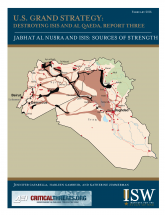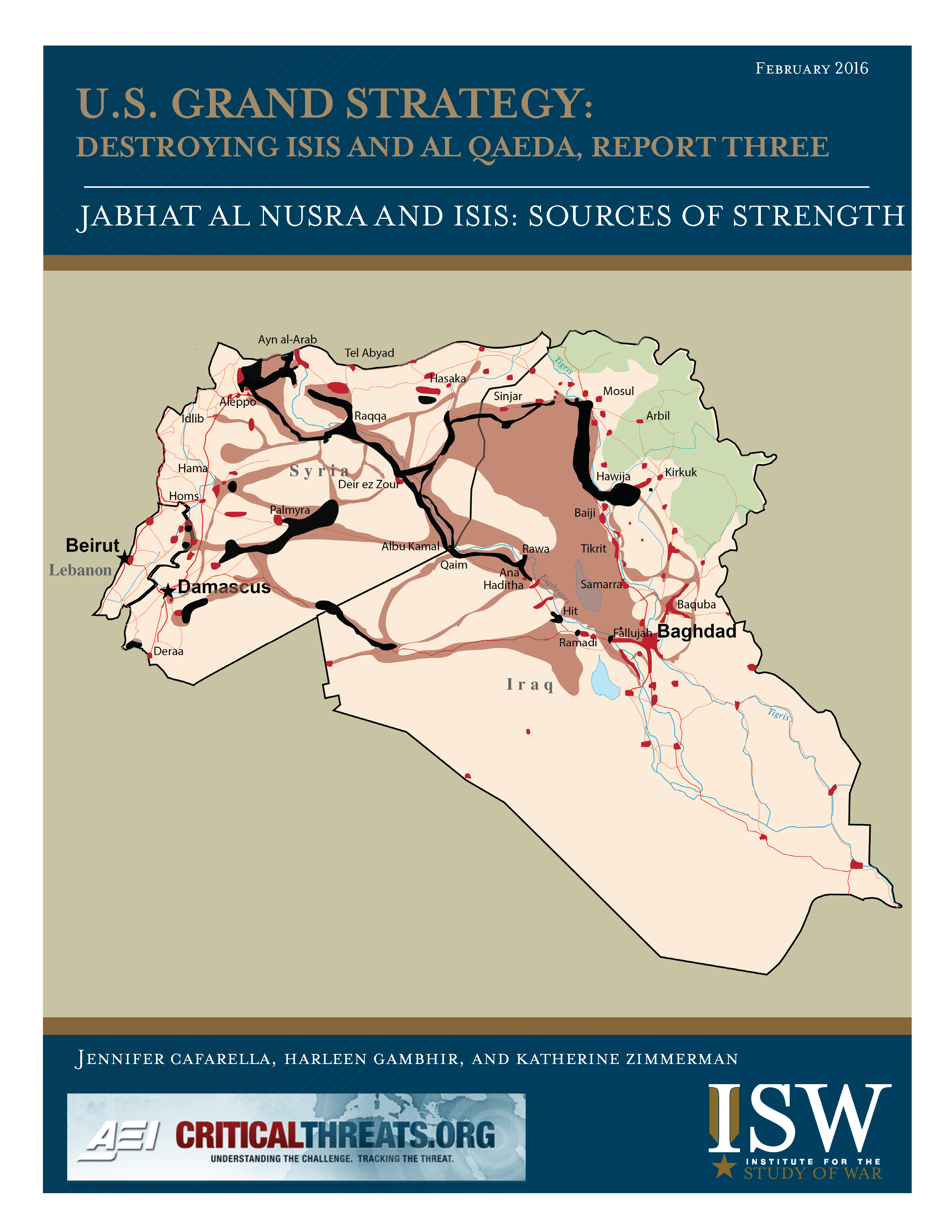 |
 |
Jabhat al Nusra and ISIS: Sources of Strength

The Institute for the Study of War (ISW) and the Critical Threats Project (CTP) at the American Enterprise Institute conducted an intensive multi-week planning exercise to frame, design, and evaluate potential courses of action that the United States could pursue to destroy the Islamic State in Iraq and al Sham (ISIS) and al Qaeda in Iraq and Syria. ISW and CTP are publishing the findings of this exercise in multiple reports in a series titled U.S Grand Strategy: Destroying ISIS and al Qaeda. The first report – Al Qaeda and ISIS: Existential Threats to the U.S. and Europe -- described America’s global grand strategic objectives as they relate to the threat from ISIS and al Qaeda. The second – Competing Visions for Syria and Iraq: The Myth of an Anti-ISIS Grand Coalition -- defined American strategic objectives in Iraq and Syria, identified the minimum necessary conditions for ending the conflicts there, and compared U.S. objectives with those of Iran, Russia, Turkey, and Saudi Arabia in order to understand actual convergences and divergences. This third report assesses the strengths and vulnerabilities of ISIS and al Qaeda affiliate Jabhat al Nusra to serve as the basis for developing a robust and comprehensive strategy to destroy them. Subsequent reports will provide a detailed assessment of the situation on the ground in Syria and present the planning group’s evaluation of several courses of action.
The key findings of this third report are:
- ISIS and al Qaeda are Salafi-jihadi military organizations with distinct sources of strength. The groups interact differently with the populations among which they operate. These differences create distinct requirements for destroying each organization.
- U.S. strategy must operate against both ISIS and Jabhat al Nusra simultaneously. Attacking the source of ISIS’s strength—its territorial caliphate—is relatively straightforward to describe. Expelling ISIS’s hybrid forces from terrain and setting conditions to prevent their return is a much more complicated task with which American and Western militaries are nevertheless familiar. Jabhat al Nusra, however, is primed to benefit from ISIS’s defeat by moving into territories from which ISIS has been cleared. Current efforts that focus on ISIS first and plan to address Jabhat al Nusra second (if at all) have a high probability of facilitating Jabhat al Nusra’s expansion.
- Current U.S. policy appears to assume that depriving ISIS of its control of Mosul or ar Raqqa will lead to the organization’s collapse. That assumption was likely valid in 2014 and early 2015, but it is no longer true. ISIS has established itself in multiple major urban centers, including Fallujah, Palmyra, and Deir ez Zour. Any of these cities in Iraq or Syria could serve as a de-facto capital for its caliphate were it deprived of Mosul and ar Raqqa. ISIS must be driven from all urban and major rural population centers in Iraq and Syria if it is to be destroyed.
- Jabhat al Nusra draws strength from its intertwinement with Syrian Sunni opposition groups. The slow pace of U.S. strategy and its exclusive prioritization of ISIS are facilitating Jabhat al Nusra’s deeper entrenchment within the opposition. It is not possible to attack this intertwinement directly, and even most indirect efforts will likely be counter-productive. Identifying means of separating Jabhat al Nusra from the opposition in order to destroy it is the most difficult intellectual task in developing a strategy for Syria, and the one on which the planning group is continuing to focus.
- All operations against Jabhat al Nusra and ISIS must be integrated into a single coherent strategic concept that takes account of the divergence of interests between the U.S. and its European partners, on the one hand, and Russia, Iran, Turkey and Saudi Arabia on the other. As the recent Russian-Iranian-regime envelopment of Aleppo shows, Moscow and Tehran are pursuing objectives antithetical to American interests and their operations will further radicalize the conflict in ways that entrench ISIS and al Qaeda.
- The U.S. and its Western partners will have to conduct multiple simultaneous and successive operations whose exact course cannot be described fully in advance. The initial operations must focus on altering the conditions on the ground in order to expose Jabhat al Nusra’s sources of strength to attack. They must alter the popular narrative that the West has abandoned the Syrian Sunni Arabs in favor of Iran, Assad, and Russia. This task will be impossible as long as the West offers the Sunni no meaningful support in the face of the Assad regime’s imminent threat to their survival as individuals and communities.
Tags
